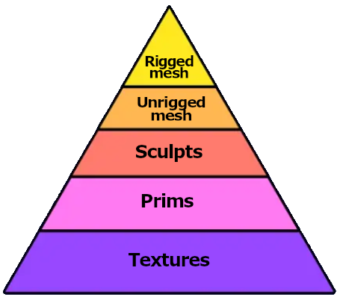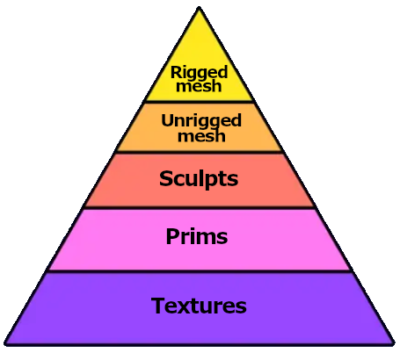
It’s been quite a long time since I blogged about the state of the clothing market. It was back in January 2014 in fact.
Back then I predicted that clothing would get ever more difficult to make and that more and more clothes would end up being made by fewer and fewer designers, and that we’d get a stagnation of the clothing market. However, when I wrote that, Fitted Mesh was in its infancy and it was unclear where it would go. And where it went was Mesh bodies. Of course this is probably not news to you as Mesh bodies have been ‘mainstream’ for over a year, apparently. I say ‘apparently’ as I haven’t been very active on SL for the past year so I am playing catch-up.
As you are probably aware, there are now a number of competing Fitted Mesh bodies available from designers like SLink, Maitreya, TMP (The Mesh Project), Belleza, and the like. A Fitted Mesh body is essentially a bodysuit that completely replaces your body (which is now being referred to as ‘Classic body’) by using an Alpha Mask to make your Classic body invisible from the neck down. Unlike with Rigged Mesh, the Fitted Mesh responds to the sliders for modifying your body (no more “standard sizes”), which in theory should mean that you still have full control over your shape and look. However, it is of much higher quality and much more realistic than the Classic body shape. In short, it is what Linden Lab should have done themselves with the Classic body.
Mesh clothing compatible with these bodies is available, and older Rigged Mesh clothing will still fit, albeit with some tweaking and the use of additional alpha masks to mask off parts of the Mesh body. How this is achieved varies by body, and some are more clunky than others. I’ll leave it up to you to research further.
For tattoos, skins, and indeed any other texture (which of course includes System Clothing textures), the designer has to provide an “applier” that is compatible with the Mesh body. An applier is essentially a script that tells the Mesh body how to paint the texture onto it. You’re probably no stranger to appliers if you have used Phat Az, Lola’s Tango and other body modifications that pre-date Fitted Mesh.
Without an applier, the texture will be worn by the Classic body which of course is hidden when you are wearing a Mesh body.
There is an applier specific to each designer’s body, but there is also an ‘Omega’ applier system which is a universal (and free) system understood by many Mesh bodies. If your body is Omega compatible (many are, with the exception of a few such as TMP and SLink Physique) you can use Omega appliers on your body.
So, with all that background information out of the way, it is time to talk about the actual subject of this post. Which, ironically, will take far fewer words to achieve than the preamble.
I recently made friends with someone and she was showing me some of her outfits, and I noticed that some of her clothes were what only a few years ago would have been dismissed as rather out-dated pre-Mesh texture clothing. Only she had fairly recently bought them because they looked ok to her, but crucially had appliers for her Mesh body.
And this got me thinking about my old post where I said that texture-only clothing designers were being left behind. Suddenly this is no longer the case. All a texture-only designer needs to do now to bring their clothing to a whole new audience is to master the ability to provide appliers. From what I can see, this is fairly straightforward and is certainly way easier than making Rigged Mesh.
My personal feelings on texture-only clothing haven’t really changed – I still think it is immensely hard to make it look realistic and even harder to give the impression of 3D shapes with only a 2D texture – and this is never more the case than with things like buckles, clasps, and the like. These will always look better implemented in a 3D medium such as prims or sculpts (in the past) and Mesh (now), but as I have previously pointed out this is much, much harder to achieve. However, traditional 2D texture clothing applied to a Mesh body certainly looks better than when applied to a Classic body – there is less of that awful distortion and glitching that really ruin it, and it definitely gives it a new lease of life to the extent that you could feel happy to wear it.
So, in summary, I think that the clothing market may have opened up somewhat because right now there is a big demand for reasonably-priced texture-only clothing that can be applied to a Mesh body. And, furthermore, texture clothing simply looks better on a Mesh body than on a Classic body to the extent that it is acceptable to wear again.
Maybe there is a place for the small hobbyist designer making texture-only clothing after all. And that has to be a good thing, because the vitality of Second Life depends on user-generated content.
Edit: Just to clarify, the creator of texture clothing must produce an Applier for you. There is currently no way of simply applying existing texture clothing to your mesh body, so unless the creator of your old pre-mesh texture clothing makes an Applier available, you’re out of luck.
Update
The above was written before we had Bakes on Mesh (BoM). Now that we have BoM it is no longer necessary to have an Applier and you can apply old texture-based system clothing directly to your Mesh body. The circle is now complete, and if you have old system clothing that you want to wear again, then you can just do so. Same for tats as well. It also means that those sellers who didn’t even bother to learn how to make Appliers can now just resell their ancient system clothing unmodified.
Further reading
WARNING: Many of the these links contain digital nudity and are NSFW.
http://strawberrysingh.com/2015/06/21/prim-perfect-introduction-to-mesh-bodies/
http://strawberrysingh.com/2014/12/16/maitreya-mesh-body/
http://juicybomb.com/2014/06/28/slink-physique/
http://alaskametro-sl.com/2014/12/i-heart-my-meshy-bits/


